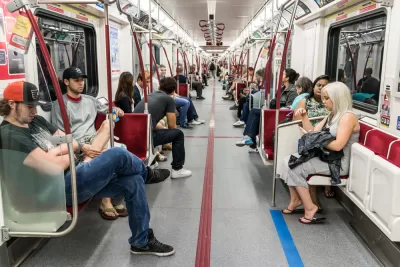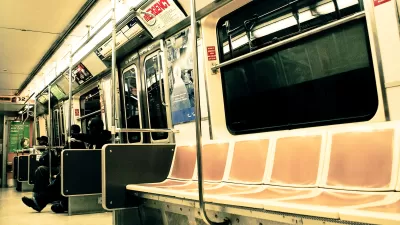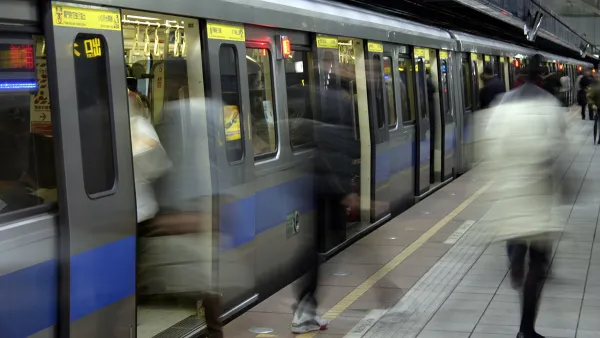The New York Times transit reporter, Emma G. Fitzsimmons, reports from Toronto to see what riders think about their 'open gangway' subway cars. By 2020, New York will receive 750 of these cars that have no doors separating the cars.

The open gangway or 'open car end' are part of an "ambitious redesign overhaul" of both subway cars and subway stations that New York Governor Andrew Cuomo unveiled in July. Rather than going to Paris to see how riders took to open gangway cars, Fitzsimmons stayed within North America and visited Toronto, the provincial capital of Ontario.
Nearly five years after Canada’s largest city introduced the spacious new cars, subway riders here — usually quick to find fault with the transit system — have given the trains a ringing endorsement.
With a clear view down the length of the train, commuters walk from car to car searching for a less crowded spot to stand. Others gather in the accordion-style passageway between cars, an area once separated by doors.
“You can fit more people, especially during rush hour,” said Louis Molnar, 43, an accountant who stood in the shifting connector between two cars on a recent evening. “In the past, sometimes you’d have to wait for the next car, and this makes it so much better.”
Other advantages of these cars were listed last year by The Transport Politic blogger Yonah Freemark (via Planetizen), who asked, "Every major train manufacturer offers trains with open gangways off the shelf. What is holding U.S. systems back?" Fitzsimmons answers:
American transit officials have had reservations about whether the design could work on the nation’s aging subways and whether ridership levels warrant the expense of switching to the new cars, said Randy Clarke, a safety and operations expert at the American Public Transportation Association. In Boston, subway officials considered the idea for new cars on two lines but decided against it.
Disadvantages:
"One downside is that if a train has a technical problem, workers must remove the entire six-car train from service, Andy Byford, the chief executive of the Toronto Transit Commission, said, instead of separating a pair of cars and replacing them. But over all, he said, the benefits have outweighed the drawbacks.
More about the Toronto subway
Toronto’s reputation as a livable city with good transit has helped it grow to more than 2.8 million people, on par with the population of Chicago. Toronto’s transit system — the third largest in North America — has about 1.7 million riders each weekday on its network of subways, streetcars and buses, but those figures are dwarfed by New York City’s nearly 6 million daily subway riders.
In a strictly subway comparison, Toronto's 62-year-old subway is the second largest in Canada and the fourth largest in North America after New York, Mexico City and Montreal.
And Fitzsimmons adds this surprising factoid on the system: you can still use tokens.
FULL STORY: What’s Next for the New York Subway? Toronto Already Knows

Montreal Mall to Become 6,000 Housing Units
Place Versailles will be transformed into a mixed-use complex over the next 25 years.

Planetizen Federal Action Tracker
A weekly monitor of how Trump’s orders and actions are impacting planners and planning in America.

DARTSpace Platform Streamlines Dallas TOD Application Process
The Dallas transit agency hopes a shorter permitting timeline will boost transit-oriented development around rail stations.

Philadelphia Swaps Car Lanes for Bikeways in Unanimous Vote
The project will transform one of the handful of streets responsible for 80% of the city’s major crashes.

Interactive Map Reveals America's “Shade Deserts”
Launched by UCLA and American Forests to combat heat-related deaths, the tool maps the shade infrastructure for over 360 U.S. cities.

Bicycles and Books — In Sacramento, Libraries Now Offer Both
Adult library card holders can check out e-bikes and e-trikes for up to one week.
Urban Design for Planners 1: Software Tools
This six-course series explores essential urban design concepts using open source software and equips planners with the tools they need to participate fully in the urban design process.
Planning for Universal Design
Learn the tools for implementing Universal Design in planning regulations.
City of Mt Shasta
City of Camden Redevelopment Agency
City of Astoria
Transportation Research & Education Center (TREC) at Portland State University
US High Speed Rail Association
City of Camden Redevelopment Agency
Municipality of Princeton (NJ)




























